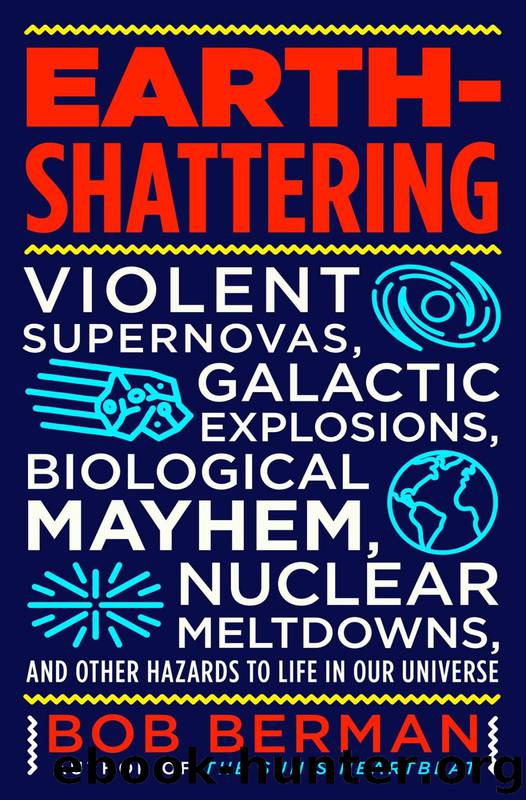Earth-Shattering by Bob Berman

Author:Bob Berman
Language: eng
Format: mobi, epub
Publisher: Little, Brown and Company
Published: 2019-02-19T00:00:00+00:00
It’s not known whether the popular 1940s and 1950s star who was born Frances Rose Shore derived her stage name from the suspiciously similar dino-saur, which means “terrible lizard.” (Paramount Pictures)
Such a violent collision between an asteroid and Earth could not fail to leave a scar. Unknown to Luis and Walter Alvarez, it had already been seen by two geophysicists looking for petroleum deposits in the late 1970s, a few years before the dinosaur-extinction paper was published. In 1991, others positively identified it as the impact location.
In the eastern Yucatán Peninsula of Mexico, essentially offshore, the giant 110-mile-wide, 12-mile-deep crater sits near the town of Chicxulub.3 In 2016, scientists laboriously drilled a mile into the seafloor just off the Yucatán coast to obtain rock-core samples from the peak ring of the crater. Radiocarbon and other dating methods showed the material included nonterrestrial components that arrived 66,038,000 years ago.
Now, armed with specific data about the impact size, we can be confident about the exact violence that was inflicted on our world. The asteroid, already estimated to be six or seven miles wide, has been upgraded to nine miles wide, although some think it could be as much as seven times bigger than that.
We can visualize the cataclysm unfolding. First the incoming asteroid, larger than Mount Everest. Though it was traveling at around twenty miles a second, or seventy thousand miles an hour, it would have seemed fairly slow as it approached. That’s because—as this author repeatedly demonstrated in his 2014 book Zoom4—an object or animal’s perceived velocity critically depends on whether the moving object is able to rapidly displace its own diameter. A horse sauntering at three miles an hour will walk its own length in two or three seconds and will not seem particularly fast. But a mouse moving at that same speed will traverse fifteen of its body lengths per second. Displacing its form fifteen times over per second makes it seem supersonic. Conversely, a jumbo jetliner approaching for a landing often appears to be virtually hovering in place even though it’s traveling fifty times faster than the scurrying mouse.
This is why a shooting star seems superfast. A meteor is a mere bright dot in the night sky. (Actually, the typical visible meteor is indeed only the size of an apple seed, although the globe of glowing, ionized air surrounding it is a few inches wide.)
The meteor is therefore traversing thousands of its own diameters per second and thus appears superfast. But on that day (or night; we don’t know which it was) sixty-six million years ago, the giant meteor, at least six miles across but possibly as wide as sixty miles, was scarcely moving its own width per second. That’s about twenty times slower-seeming than a bowling ball heading toward the pins. Not exactly lethargic, but not brisk either.
No matter. When it hit the Earth, traveling more than forty times the speed of sound, its impact unleashed the same energy as ten billion Hiroshima bombs. Giant tsunamis the height of sixty-story buildings spread across the Caribbean.
Download
This site does not store any files on its server. We only index and link to content provided by other sites. Please contact the content providers to delete copyright contents if any and email us, we'll remove relevant links or contents immediately.
| Aeronautics & Astronautics | Astronomy |
| Astrophysics & Space Science | Comets, Meteors & Asteroids |
| Cosmology | Mars |
| Solar System | Star-Gazing |
| Telescopes | UFOs |
Tools of Titans by Timothy Ferriss(8218)
Turbulence by E. J. Noyes(7936)
Secrets of Antigravity Propulsion: Tesla, UFOs, and Classified Aerospace Technology by Ph.D. Paul A. Laviolette(5309)
Astrophysics for People in a Hurry by Neil DeGrasse Tyson(5133)
Room 212 by Kate Stewart(5037)
Design of Trajectory Optimization Approach for Space Maneuver Vehicle Skip Entry Problems by Runqi Chai & Al Savvaris & Antonios Tsourdos & Senchun Chai(5011)
Pale Blue Dot by Carl Sagan(4912)
The David Icke Guide to the Global Conspiracy (and how to end it) by David Icke(4625)
A Journey Through Divination and Astronomy by Publishing Pottermore(4344)
Goodbye Paradise(3728)
Apollo 8 by Jeffrey Kluger(3637)
COSMOS by Carl Sagan(3554)
Losing the Nobel Prize by Brian Keating(3499)
The Five People You Meet in Heaven by Mitch Albom(3475)
How to Read Water: Clues and Patterns from Puddles to the Sea (Natural Navigation) by Tristan Gooley(3409)
Brief Answers to the Big Questions by Stephen Hawking(3369)
How to Read Nature by Tristan Gooley(3249)
The Order of Time by Carlo Rovelli(3145)
A Brief History of Time by Stephen Hawking(2962)
